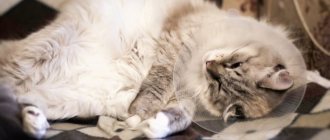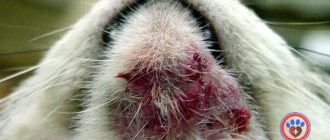Why does my cat's ears smell?
It should be immediately mentioned that normally there should be no unpleasant odor coming from the animal’s ears.
The main reason for this phenomenon can be safely called the development of inflammation of the auditory canal (otitis externa), accompanied by the proliferation of pathogenic microorganisms and the formation of various secretions. Due to the structural features, all problems with the ears of animals are classified as dermatological, that is, skin diseases. As a rule, it all starts with the formation of excess sulfur secretion. This can be either a physiological feature of the cat, when the ear glands produce excessive amounts of wax, or a consequence of other problems.
Allergy
For example, it is common for a cat to have smelly ears due to an allergic reaction, when inflammation and swelling in the ear canal appear as a result of the animal’s reaction to an allergen in the environment or food. A predisposing factor may be a violation of the normal removal of ear secretions, which is especially important for fold-eared cats.
Accumulated earwax becomes an excellent substrate for the proliferation of microorganisms, including yeast-like fungi and bacteria. They often jointly populate the ear canal, causing discharge from the ears (even purulent), inflammation, severe itching and pain. As a result, the ears begin to smell unpleasant.
Other causes of odor
In addition, the reasons why a cat’s ears smell can be:
- neoplasms in the auditory canal;
- gland cysts;
- inflammation due to injury (including due to improper ear cleaning);
- entry of a foreign body into the auditory canal;
- systemic disease (for example, otitis often occurs against the background of hypothyroidism);
- ectoparasites.
Tick-borne otitis media
Ectoparasites include microscopic mites that parasitize the skin of pets. Unlike other types of diseases, tick-borne otitis media is contagious and is transmitted from cat to cat, so the chance of contracting it increases many times over if the animal goes outside. Mites of the genera Demodex, Notoedres, Sarcoptes, but most often Otodectes are found in the ear canals.
At the same time, cats feel severe itching, scratch their ears and shake their heads, and dark and thick discharge resembling coffee grounds accumulates in the ear canal. All this is often accompanied by bacterial and fungal infections, which aggravates inflammation and leads to the appearance of an unpleasant odor.
Treatment of skin diseases in cats
Treatment of all diseases must be carried out under the supervision of a veterinarian. Treatment regimens are selected based on age, weight, cause and may vary significantly. Self-medication is fraught with death and worsening of the situation.
Table. Treatment of skin diseases
| Disease | Treatment |
| Flea dermatitis | Complete destruction of fleas using shampoos, tablets, drops (“Advocate”, Beaphar, “Frontline”, “Bars”), disinfestation of places of residence (“Flyblock”, “Tsifoks”), washing wounds with “Miramistin”, lubrication with antibacterial ointments (“ Methyluracil, Levomekol) |
| Acne | Treatment with antiseptics (Miramistin, Chlorhexidine), washing with antibacterial shampoos (tar, special veterinary compounds), corticosteroids and antibiotics orally and locally for advanced cases (Amoxiclav, Kanamycin, Vetrimoxin, Prednisolone) |
| Allergic reactions | Taking antihistamines (Diphenhydramine, Cetirizine), antibiotics and corticosteroids for acute reactions (Dexamethasone, Prednisolone), washing with decoctions of chamomile, calendula, medicated shampoos from a veterinary pharmacy |
| Eczema | Taking antihistamines, vitamins and sedatives (Cat Bayun, Zirtek, Beaphar, Sanal), ointments (Tetracycline, Levomekol) |
| Ear mite | Regular cleansing of the ears (at least 2 times a day) with Miramistin, acaricidal drops according to the prescription (Otovedin), tampons with Levomekol in the ear canals after drops, sprinkling with streptocide on external wounds |
| Sarcoptic mange | Drops of "Stronghold" on the cat's withers according to instructions, cleaning of premises, hygiene |
| Notoedrosis | Bathing with acaricidal or keratolic shampoo (sold in the veterinary pharmacy Beaphar, "Bars"), local application of aversectin ointment, "Demos", aqueous emulsion of neocidol, drops of "Stronghold" or sulfur ointment, disinfestation of premises |
| Seborrhea | Degreasing and astringent shampoos (“Bars”, “Frontline”), treatment of combed wounds with brilliant green or “Streptocide” |
| Pyoderma | Antibacterial drugs orally (Sulf 120, Tsiprovet), antiseptic ointments and solutions for wounds (Hydrocortisone, Chlorhexidine, Belogent) |
| Demodicosis | Antiparasitic shampoos, washing lotions (“Bars”, “Bifar”, “Parastop”), wearing a flea and tick collar (“Bifar”, “Bars”), dusting the affected areas with tick powder (“Clandestine”), injections prescription antibiotics (Betamox, Xiclav), treatment of affected skin with Miramistin |
| Ostiofolliculitis | An antimicrobial drug orally (according to the results of culture "Sinulox"), treating the skin with an antiseptic (brilliant or alcohol solution), taking immunomodulators and vitamins according to prescription ("Sanal") |
| Abscesses | Washing wounds with Miramistin, applying Vishnevsky ointment to the site of the abscess |
| Malasseziosis | Washing with fungicidal shampoos (Bifar), wiping the skin with an antiseptic (Miramistin, Chlorhexidine), Levomekol on the affected areas, antibiotic therapy as prescribed (Econazole 1%, Amphotericin B 3%, Clortimazole 1 %, "Flucytosine" 10%) |
| Ringworm | Antifungal shampoos with miconazole, chlorhexidine (Api-san), lubricating the affected skin with Mycoseptin, Clotrimazole, Sanoderm, Yam, Nizoral, orally or injections of Fluconazole, Terbinafine, immunosuppressants in tablets or injections (“Vetom”, “Ribotan”, “Imunofan”), brilliant green for ulcers |
| Atopic dermatitis | Treatment of an internal provoking disease (kidney, liver, etc.), diet after an allergen test, antihistamines as prescribed by a doctor (Tavegil, Cetrin), soothing ointments or washing with chamomile solution |
| Cushing's syndrome | "Trilostane" as prescribed by a veterinarian (to suppress cortisol), removal of the adrenal glands or radiation therapy of the pituitary gland as prescribed, local antihistamine ointments for skin lesions ("Hydrocortisone", "Yam") |
Treatment of diseases is comprehensive. It is necessary to follow all the veterinarian's recommendations and perform all therapeutic actions.
How to find out the cause of an unpleasant odor?
Owners should be concerned about the appearance of an unpleasant odor from their cat’s ears. The first thing to do is to carefully examine the ear; you can even shine a flashlight inside the ear canal. Of course, you will not be able to examine the entire ear canal (it has a bend), but even such a cursory examination will help identify the presence of a problem.
The presence of any visible discharge (yellow, brown, black, the appearance of blood) and redness should be alarming - they may be a sign of otitis media, which means that the cat needs veterinary care.
The veterinarian will be able to look at the condition of the entire ear canal using a special device - an otoscope, and also take tests. For external otitis, a smear is usually taken from the ear, and in rare cases, a biopsy (a piece of tissue) is taken. Only an accurate diagnosis will help eliminate the cause of the disease.
Diagnosis and treatment
If the owners notice that their furry pet has an earache, he often shakes his head, scratches his ears, eats poorly or refuses food altogether, becomes lethargic, inert, does not play at all, and reacts unusually aggressively to an attempt to touch the ear, screaming loudly, hisses, in a word, behaves completely inappropriately - this is a direct indication to urgently place the cat in a carrier and take him to the veterinary clinic. There the doctor will check the condition of the ears, take a swab, and examine his body.
If he detects discharge from the ear, the presence of an inflammatory process, traces of claws or bites on the animal’s body, inflammation of the inguinal lymph node, increased body temperature and other symptoms, he will prescribe special medications that, in case of severe disease, will be administered to the cat in a hospital hospital setting.
In cases where the owners sought help in a timely manner and the disease is in its early stages, the veterinarian will prescribe the necessary medications and prescribe the correct treatment.
It must be comprehensive. First of all, eliminate the irritant as much as possible. For example, in case of food allergies, it is necessary to identify the source of the disease and transfer the cat to a healthy, harmless diet.
For other diseases, after receiving test results, the doctor prescribes specific treatment, which must be carried out strictly according to his instructions.
What to do to get rid of an unpleasant odor?
The first thing to do if your cat has smelly ears (of course, in the absence of obvious inflammation and severe pain in the area) is to clean the ear canal of excess secretions. For this purpose, a large number of hygiene lotions are sold, often with the addition of light anti-inflammatory and antiseptic components.
The lotion (you shouldn’t skimp, it’s better to pour in more liquid, at least half a milliliter) is dropped into the cat’s ear, after which the base of the auricle is massaged, and thus the solution is distributed throughout the entire ear canal.
After this, excess fluid along with impurities are removed from the ear canal naturally; the person only needs to wipe the inside of the auricle with a cotton swab. You can repeat the procedure several times - let the cat shake its head for a while and thus get rid of everything unnecessary.
After cleansing, you can begin instilling medicinal drops if prescribed by your doctor. Sometimes systemic treatment with tablets or injections is required, for example, for severe bacterial infections. In rare cases, for example, with neoplasms or severe narrowing of the auditory canal, surgery may be required.
And yet, most often the cause of unpleasant odor from the ears is excessive secretion of ear fat. In this case, it will be enough to periodically perform hygiene procedures to maintain the cleanliness and health of the auditory canal.
How is the treatment carried out?
General recommendations
Part of the treatment of the disease is cleansing the auditory organs with peroxide.
The treatment regimen is directly related to the factor that provoked the stench from the cat’s ear. When the inflammatory process is accompanied not only by a bad odor, but also by suppuration, pet owners will need to cleanse the ear organ of pus daily. To carry out the procedure, you will need to follow the following algorithm of actions:
- Get rid of fur from the inside of the ear.
- Using a cotton swab and disinfectant solutions, clean the ear from discharge. It is recommended to use hydrogen peroxide.
- Dry the ear. It is permissible to use gauze, a bandage or a napkin, carefully blotting the organ.
After these manipulations, you need to resort to the help of medications prescribed by the veterinarian. For example, if a cat is diagnosed with otitis media, medications are prescribed that have a bactericidal, anti-inflammatory, anesthetic, antimycotic effect. Ear drops "Aurikan" and "Surolan" are often used. You will need to instill medications into both ears, even in a situation where only one is affected.
The right approach to nutrition
It is important that the animal eats vegetables during illness.
During therapy, the pet owner will need to monitor its diet. It is important to include food in the menu that is well digestible and contains a sufficient number of microelements and vitamins. It is recommended to feed cats lean meats, vegetables, rice and buckwheat, chicken and quail eggs. Once a week it is permissible to pamper your cat with boiled fish and fermented milk products. As for industrial feeds that are sold in stores, veterinarians from the Zoovet clinic recommend abandoning them during therapy. Such precautions are due to the fact that allergens may be present in their composition.
It is permissible to return to ready-made food only after the source of allergic reactions in the cat has been accurately identified.











